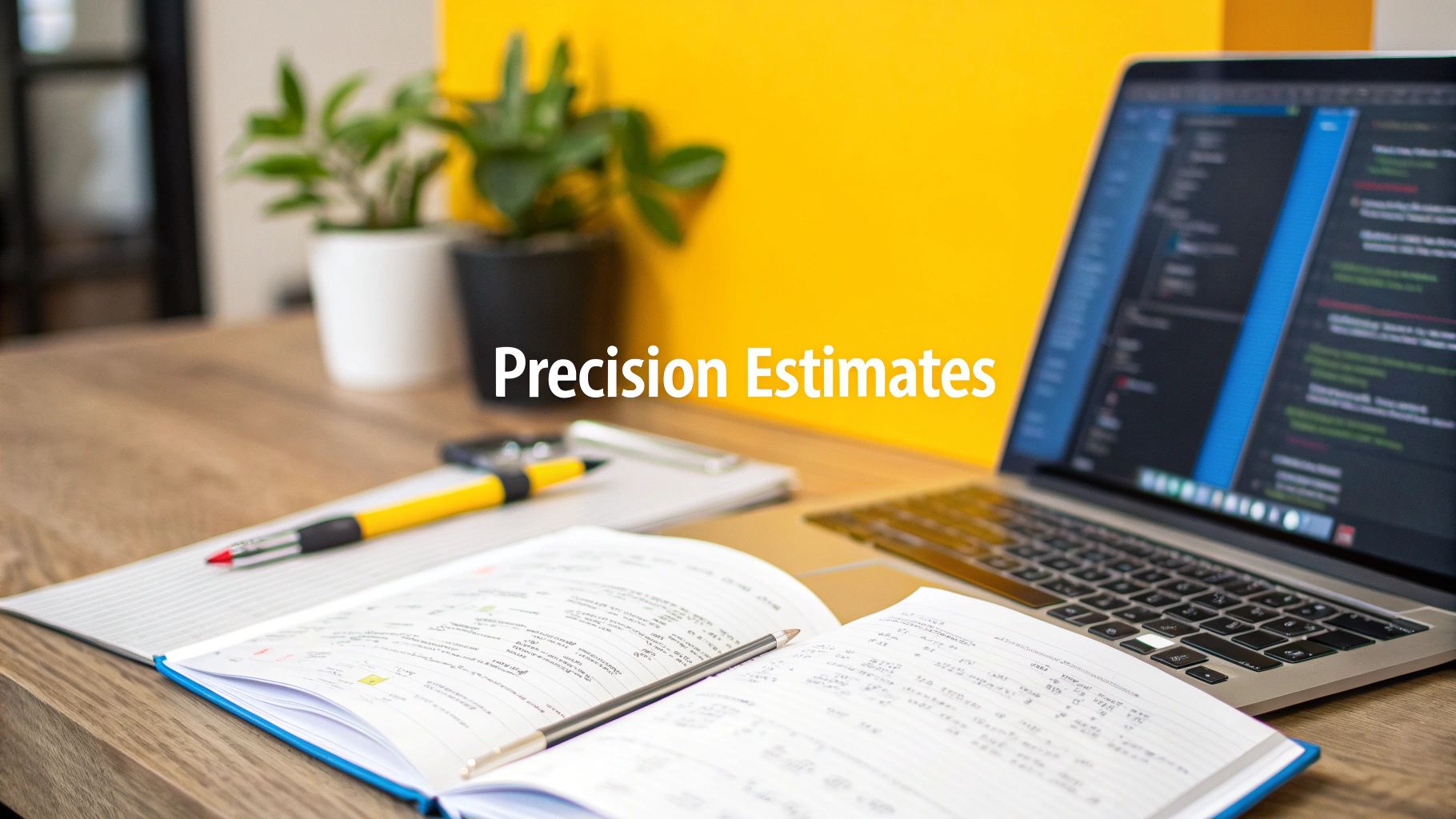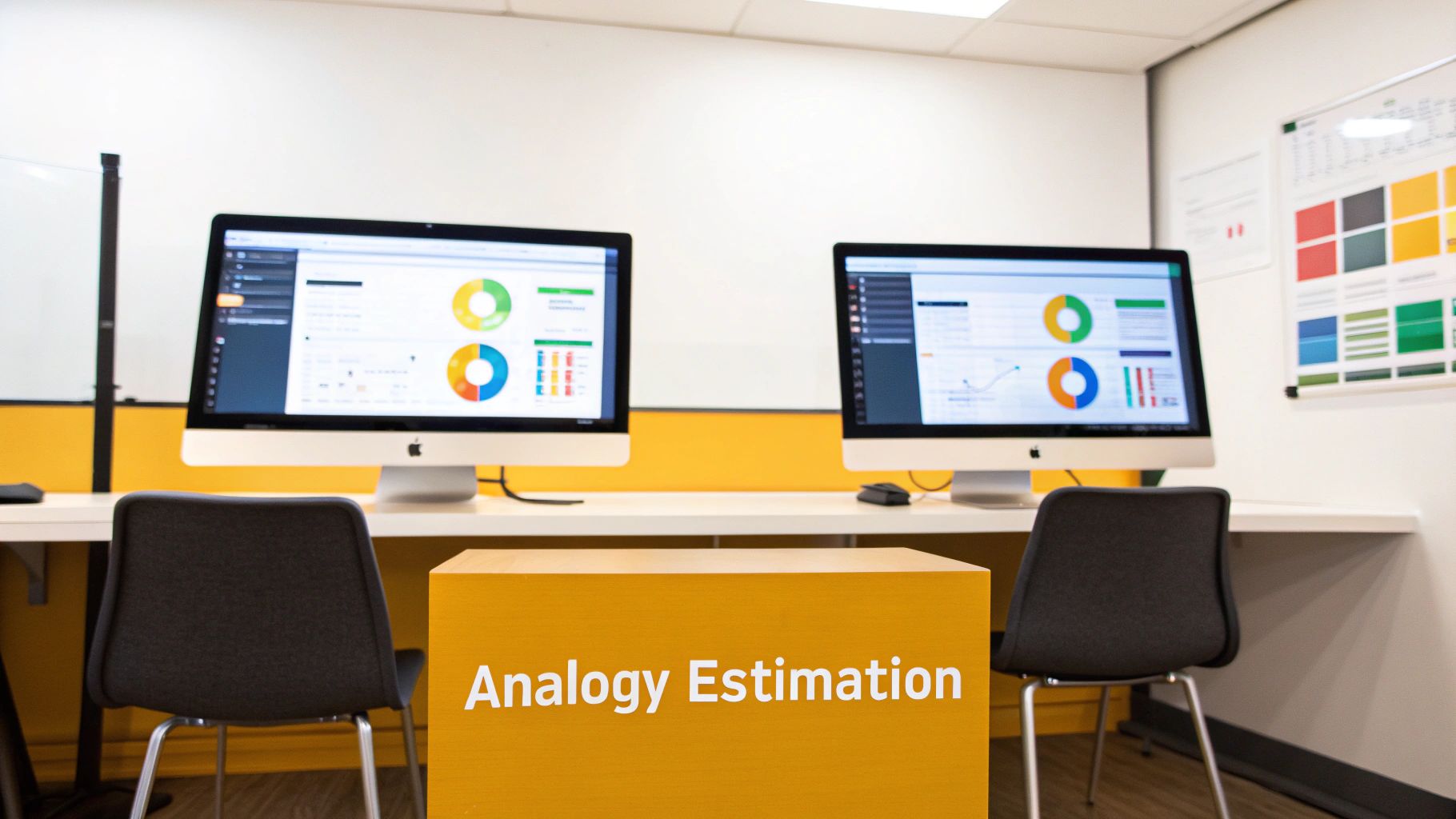Software Estimation Techniques for Project Success

Software estimation isn't just about picking a number out of thin air. It's a set of structured methods for figuring out how much time, money, and manpower you’ll actually need to get a software project over the finish line. These techniques help turn a wild guess into a calculated forecast by digging into the project’s requirements and breaking down the work.
Why Accurate Software Estimation Matters
Ever been on a project that completely spiraled out of control? Deadlines fly by, the budget is a distant memory, and everyone is scrambling. This all-too-common scenario usually traces back to one thing: poor estimation.
Trying to build software without a solid estimate is like building a house without a blueprint. You have a vision, sure, but without calculating the lumber, labor, and potential hiccups, you’re just asking for expensive surprises down the road.
That's where effective software estimation techniques come in. They aren't crystal balls meant to predict the future with 100% certainty. Instead, think of them as strategic tools that help you make smart, informed decisions from day one.
The Foundation of Predictable Delivery
Good estimation is the bedrock of any reliable project plan. It lets you set deadlines that are actually achievable and manage what your stakeholders expect right from the start.
When your estimates are built on solid data and thoughtful analysis, they give the entire team a clear roadmap. This cuts down on the chaos that comes from constantly putting out fires or dealing with unexpected scope creep. That kind of predictability builds trust with clients and gives your team the confidence to deliver consistently. For overall success, strong estimation must go hand-in-hand with broader IT project management best practices.
Core Benefits of Strong Estimation Skills
Getting good at estimation fundamentally changes how you run projects, and the advantages are huge.
- Improved Resource Allocation: When you know the likely effort involved, you can assign the right people with the right skills to the right tasks. This prevents team burnout and makes sure nobody’s time is wasted.
- Proactive Risk Management: The very act of estimating forces you to think about what could go wrong. You'll naturally start identifying technical hurdles, fuzzy requirements, or third-party dependencies. Spotting these risks early makes them far easier to handle.
- Better Strategic Decisions: Solid estimates fuel smarter business decisions. They help you calculate a project's potential ROI, decide which features to build first, and determine if the whole thing is even financially viable.
A good estimate is an estimate that provides a clear enough view of the project reality to allow the project leadership to make good decisions about how to control the project to hit its targets. - Steve McConnell, Author of Software Estimation Demystifying the Black Art
At the end of the day, the goal isn't just to land on a perfect number. It's about creating a shared understanding of the work ahead, being transparent, and steering the project toward a successful launch.
A Look at Traditional Estimation Models
Long before Agile became the industry norm, software development operated on a different rhythm. Projects were often huge, multi-year endeavors where predictability was king. To get a handle on timelines and budgets, teams relied on structured, predictive models. These traditional software estimation techniques are the foundation of everything that came after, offering a formula-based approach to what can often feel like a chaotic process. They shine in environments where project requirements are locked in from the start—think large-scale government contracts or enterprise systems built using a strict Waterfall model.

The jump from simple guesswork to these structured methods was a massive leap forward for the industry. Things really started to change in the 1970s with the introduction of algorithmic models like Barry Boehm's COCOMO, which brought mathematical rigor to estimating effort. Then, the 1980s gave us Function Point Analysis (FPA), a brilliant method that shifted the focus from technical details to the actual functionality delivered to the end-user. You can dig deeper into how these methods have evolved over time by checking out this great article on up-to-date software estimation techniques on ourcodeworld.com.
The COCOMO Model
Picture COCOMO (Constructive Cost Model) as a detailed recipe for building software. The core ingredient is the estimated number of lines of code (LOC). Just like a chef scales a recipe up or down depending on how many people they're feeding, COCOMO adjusts the estimated effort based on the sheer size of the codebase.
But any good chef knows a dish is more than just its main ingredient; it’s the spices that give it character. For COCOMO, these "spices" are called cost drivers. These are all the other factors that can impact the project, like the skill level of your team, the complexity of the software, and how reliable it needs to be. A team of seasoned experts might whip through the project, while a mission-critical system for a hospital will naturally require a lot more care and time.
COCOMO’s real power is that it forces you to put numbers to things that are often just gut feelings. It gives you a repeatable, data-driven framework to work with.
This model is most accurate when you have solid historical data from similar projects to fine-tune the formula. If you don't, estimating the lines of code upfront can feel like a shot in the dark, which can throw off the entire calculation.
Function Point Analysis
If COCOMO is about measuring what goes into the kitchen, Function Point Analysis (FPA) is all about evaluating the finished meal from the diner's perspective. It completely sidesteps the technical nitty-gritty and instead measures the business functionality the software provides.
Think of it like estimating the value of a house. Instead of just looking at the total square footage, you’d count the things that matter to the person living there: the number of bedrooms, bathrooms, windows, and doors. These are the functional components a user actually interacts with.
FPA does something very similar by counting five specific types of components:
- External Inputs: Data coming into the system (e.g., a user filling out a contact form).
- External Outputs: Information leaving the system (e.g., generating a report or displaying a confirmation message).
- External Inquiries: A user request that pulls data from the system without changing anything.
- Internal Logical Files: Groups of data that the system maintains internally.
- External Interface Files: Data shared with other applications.
Each of these components gets a "weight" based on its complexity. You add them all up to get a "function point" score. This score can then be used with historical data to estimate the actual effort required. The beauty of FPA is that it’s technology-agnostic, making it a fantastic tool for comparing projects built with different tech stacks or for getting a solid estimate long before a single line of code is ever written.
A Look at Modern Agile Estimation Techniques
As software development teams moved away from rigid, long-term plans, their estimation methods had to change, too. The old-school models were great for projects with fixed requirements, but they just couldn't keep up with the fluid, iterative nature of modern development. This is where Agile estimation techniques came in, born from a need to be more flexible and realistic.
Instead of chasing perfect, long-range predictions, these methods focus on collaboration, relative sizing, and getting continuous feedback.

The core idea is simple: it's better to be roughly right in the short term than precisely wrong in the long term. Agile teams know that the further out you try to look, the blurrier things get. By estimating small chunks of work, they can deliver value quickly and adjust their course based on what they're actually accomplishing, not just an initial guess. These techniques are the engine behind frameworks like Scrum, which you can learn more about in our guide on what is Scrum methodology.
Planning Poker and Building Consensus
Ever been in a meeting where you're asked to estimate a task? A senior developer might casually say, "Oh, that's two hours," while a junior dev is silently thinking, "That's a whole day, at least!" The thing is, they could both be right based on their own experience. Planning Poker is a clever, gamified way to bring those different viewpoints to the surface and land on a realistic, shared estimate.
Here’s how it works: instead of just blurting out numbers, each team member gets a deck of cards with values from a modified Fibonacci sequence (like 1, 2, 3, 5, 8, 13). For each task, or "user story," everyone picks a card that represents the effort and reveals it at the same time. If the numbers are all pretty close, awesome—you pick a number and move on.
But the real magic happens when the estimates are wildly different. When one person plays a 3 and another plays a 13, it sparks a crucial conversation. The person who voted high and the person who voted low explain their thinking. This process almost always uncovers hidden complexities, dependencies, or simple misunderstandings. The discussion itself is often more valuable than the final number, as it ensures everyone is on the same page before any work begins.
Getting a Handle on Story Points
One of the biggest mental shifts in Agile is moving from estimating in hours to using Story Points. It’s best to think of them not as units of time, but as a measure of overall effort. Imagine levels in a video game—a "Level 1" task is straightforward, while a "Level 8" task is a beast with lots of complexity, risk, and unknowns.
Story Points are all about relative sizing. The question isn't, "How many hours will this take?" It's, "How big is this task compared to that other task we've already done?"
This seemingly small change has some big benefits:
- It separates effort from the clock. This approach naturally accounts for all the things that eat into a developer's day—meetings, interruptions, and helping teammates—without the pressure of time-tracking every minute.
- It embraces the unknown. A task that's fuzzy or has a lot of unanswered questions gets a higher point value, which automatically builds in a buffer for the team to figure things out.
- It helps with forecasting. Over time, a team calculates its velocity—the average number of story points they complete in an iteration (or "sprint"). This becomes a surprisingly reliable metric for predicting how much work they can realistically take on in the future.
The Wideband Delphi Method
While Planning Poker is perfect for the day-to-day grind of sprint planning, sometimes you need to estimate something bigger, like a major feature or an entire project. For that, the Wideband Delphi method provides a more structured approach to getting expert opinions without the bias of groupthink.
It's an anonymous, multi-round process. A group of experts provides their individual estimates in private. A facilitator then gathers the estimates, removes the names, and shares the range with the group. The team discusses the results—especially the outliers—and then re-estimates. This cycle repeats until the estimates start to converge on a single, well-vetted number.
It’s clear that these collaborative, expert-driven techniques are at the heart of modern estimation. In fact, one analysis of software estimation research found that Planning Poker and other expert-based methods made up a significant portion of the conversation, with studies on Planning Poker alone accounting for about 25% of research papers, and Wideband Delphi and Story Points each covering another 12.5%.
How to Choose the Right Estimation Technique
Picking the right software estimation technique isn't about finding one silver bullet. It's more like a carpenter choosing the right tool for the job. You wouldn't use a sledgehammer for fine cabinetry, and you shouldn't force a rigid estimation model on a fast-paced, fluid project. The best choice is always the one that fits your project’s specific situation.
Getting it right comes down to asking a few key questions. Think of these factors as a compass, guiding you toward the estimation approach that will work best for your team and your goals.
Assess Your Project’s Stability and Scale
First, take a hard look at your project requirements. Are they set in stone, or are you expecting them to change as you go?
For a project with a very stable, locked-in scope—say, a mandatory compliance update—a traditional method like Function Point Analysis works beautifully. The predictability of the requirements means you can do a detailed, upfront analysis and get a pretty accurate number.
On the other hand, if you're building a brand-new product where user feedback is expected to shape the final result, you need something more flexible. This is where an Agile technique like Story Points really shines, as it’s designed to handle uncertainty and shifting priorities. A well-crafted sample software requirements document is a huge help in figuring out just how stable your requirements are from the get-go.
Project size and complexity also matter a great deal. For small, straightforward tasks, a simple consensus-based method like Planning Poker can be more than enough. But for a massive, multi-year enterprise system, you’ll likely need a more structured, formula-based approach like COCOMO to give stakeholders the high-level budget and timeline forecasts they need.
Evaluate Your Team and Data Availability
Next, you need to look inward at your team’s process and the resources you have on hand. The most obvious starting point is whether you're working in a Waterfall or Agile environment. This alone will narrow down your options significantly.
Waterfall Projects: These projects move in a sequential, phase-by-phase manner. They really benefit from techniques that provide a comprehensive estimate right at the start. Models like COCOMO and Function Point Analysis are a natural fit for this kind of long-range planning.
Agile Projects: Iterative development is all about adapting as you go. Techniques like Story Points and Planning Poker were created specifically for this world, allowing teams to estimate small chunks of work and continuously refine their forecasts with each sprint.
Finally, consider what kind of data you have to work with. If your organization has years of data from past projects, you're in luck. Data-driven methods like Analogy-Based Estimation or other parametric models become incredibly powerful tools. Nothing predicts future effort more reliably than your own team's past performance.
No historical data? No problem. You can start with expert-driven methods like Wideband Delphi or Planning Poker. The most important thing is to start tracking now. The data you collect on your estimates versus the actual time spent will become your most valuable asset for every project you tackle down the road.
To help you visualize how these methods stack up, here’s a quick-glance comparison of the most common techniques.
Comparison of Software Estimation Techniques
This table breaks down the most popular estimation methods, showing you where each one shines and what to watch out for.
| Technique | Core Principle | Best For | Pros | Cons |
|---|---|---|---|---|
| Expert Judgment | Relies on the intuition and experience of senior team members. | Quick, early-stage estimates when detailed data is unavailable. | Fast and simple; leverages deep domain knowledge. | Highly subjective; can be biased by individual optimism or pessimism. |
| Analogy-Based | Compares the current project to similar past projects to estimate effort. | Projects where good historical data exists for comparable work. | Grounded in real-world data; relatively easy to explain. | Finding a truly comparable past project can be difficult. |
| Function Points | Measures the functional size of the software based on user-facing features. | Data-intensive, business systems with well-defined requirements. | Independent of technology; provides a consistent measure of size. | Complex to calculate; requires specialized training. |
| Story Points | Uses relative sizing (e.g., S, M, L) to estimate the effort for user stories. | Agile and Scrum projects with evolving requirements. | Fosters team consensus; accounts for complexity, not just time. | Can be misunderstood as a measure of time; velocity can fluctuate. |
| COCOMO | An algorithmic model that uses project size (lines of code) to predict effort and duration. | Large, traditional (Waterfall) projects requiring upfront planning. | Provides a structured, repeatable process; considers multiple cost drivers. | Heavily reliant on an accurate line-of-code estimate, which is hard to get early. |
Choosing the right technique is the first step toward building a realistic and reliable project plan. By matching the method to your project's unique DNA, you set your team up for success from day one.
Looking at Data-Driven and Hybrid Models
While traditional and Agile methods give you solid frameworks, some of the most accurate estimation techniques are the ones that treat your own project history like a goldmine of data. These advanced approaches move past gut feelings and turn estimation into more of a science.
The core idea is simple but powerful: your team’s past performance is the best predictor of its future performance. By methodically tracking and analyzing your data, you can build models that are perfectly tuned to how your team actually gets work done.

This isn’t a brand-new concept. One of the earliest examples is the SLIM® (Software Life Cycle Management) methodology, developed by Larry Putnam way back in 1978. It was a groundbreaking model that used historical project data and mathematical formulas to predict schedules, effort, and even defect rates. It really paved the way for many of the statistical tools we use today. You can read more about this foundational method and its influence by exploring the history of software estimation on qsm.com.
Using Your Own History as a Guide
One of the most straightforward yet effective data-driven methods is analogy-based estimation. Think of it as finding a "project twin." You sift through your past projects to find one that’s incredibly similar in scope, complexity, and technology to the one you're about to start.
From there, you use the actual cost and timeline from that old project as the starting point for your new estimate, adjusting up or down for any key differences.
This technique is refreshingly simple and based on real-world results. Its accuracy, though, really hinges on two things:
- How good and detailed your historical records are.
- How genuinely similar the past project is to the new one.
The big takeaway from data-driven models is that your organization's own history is its most valuable asset for accurate estimates. It automatically accounts for your unique processes, team skills, and work environment better than any generic industry benchmark ever could.
Creating Smart Hybrid Models
You don’t have to lock yourself into a single estimation technique for an entire project. Hybrid models give you the flexibility to mix and match, blending the strengths of different methods at various stages. This lets you use the right tool for the job at the right time.
For instance, a team might start with a broad, structured technique for initial planning and then shift to a more nimble method once development is underway.
Here’s what that could look like:
- Phase 1 (Initial Sizing): Kick things off with Function Point Analysis to get an objective, tech-neutral size estimate for the whole project. This gives you a firm baseline for early budget talks and high-level roadmapping.
- Phase 2 (Sprint Planning): Once the work begins, the team switches to Story Points and Planning Poker. This brings the estimation process down to the ground level, allowing developers to make collaborative, detailed estimates for the tasks directly in front of them.
This two-step approach gives stakeholders the long-range forecast they need for planning while empowering the dev team with the flexibility essential for an Agile environment. By getting creative and combining techniques, you can build a process that is both reliable and adaptable.
Practical Steps to Sharpen Your Estimation Accuracy
Picking the right software estimation technique is a great start, but it's only half the story. To get forecasts you can actually count on, you have to put that theory into practice consistently. It doesn't matter which method you land on; a few fundamental habits will make all the difference.

Your first move should always be to slice up those huge, intimidating tasks into smaller, bite-sized pieces. We often use a Work Breakdown Structure (WBS) for this. Trying to estimate a massive feature is a recipe for a wild guess. But estimating ten small sub-tasks? That's far more manageable and leads to much greater accuracy.
It's also crucial to remember that estimates aren't promises set in stone. Think of them as living documents that should—and will—change as the fog of uncertainty clears.
Embrace the Cone of Uncertainty
The "Cone of Uncertainty" is a brilliant way to visualize a simple truth in software development: our estimates are fuzziest at the very start of a project and get sharper as we learn more.
At kickoff, an estimate could easily be off by a factor of four. But as your team refines requirements, prototypes solutions, and tackles technical hurdles, that wide cone of possibility narrows down significantly.
This concept isn't just a technical model; it's a fantastic communication tool. It helps you manage stakeholder expectations, making it clear why early forecasts are so broad and that precision will improve with time. Being upfront about this is a cornerstone of effective project planning for software development.
The real goal of estimation isn’t to perfectly predict the future. It’s to reduce uncertainty just enough so you can make smart decisions about where to go next.
At the end of the day, solid estimation comes from combining the right technique with a culture of learning and refinement. Always track your estimates against the actual time spent. When there's a gap, talk about it openly—without pointing fingers—and feed those lessons back into your process. That’s how you get better with every project.
Frequently Asked Questions About Estimation
Putting software estimation into practice is where the real questions pop up. Here are some quick, no-nonsense answers to the tricky situations teams run into all the time, helping you handle them like a pro.
How Do You Estimate Projects with Unfamiliar Technologies?
When you’re staring down a new technology, the worst thing you can do is guess at a single, precise number. The smart move is to plan for the unknown and build in time for learning.
First, lean on your network. A method like Wideband Delphi is perfect for this—it pulls together insights from different experts who might have experience with something similar.
Next, run a "spike." This is just a small, time-boxed research task. Think of it as a mini-experiment where the only goal is to learn enough about the new tech to reduce uncertainty. It's not about building a feature, it's about building understanding.
Finally, give a ranged estimate. Be upfront about the uncertainty. Saying something will take 4-6 weeks is far more honest and useful than pretending you know it will take exactly 5. You can always tighten that estimate after your initial research spike.
How Do I Handle Stakeholders Who Demand Fixed Estimates?
Ah, the classic question. This one is less about numbers and more about managing expectations and a little bit of education. Stakeholders aren't being difficult; they just need predictability for their own planning and budgeting.
The trick is to shift the conversation away from one big, fixed number for the entire project.
Start by giving them a high-level forecast, like 6-9 months, which is good enough for their initial planning. But—and this is the important part—explain that you can only give a firm, committed estimate for the immediate work, like the next 2-3 sprints.
This is the perfect moment to introduce them to the "Cone of Uncertainty." Pull up a diagram and show them visually how estimates become more accurate as you get closer to the work. It’s a powerful way to build trust and show them you have a professional process, not just a crystal ball.
What Is the Best Way to Start Without Historical Data?
If you're starting from scratch with no past project data, your team's collective brainpower is your single greatest asset. You’ll want to start with techniques that get everyone talking.
Planning Poker is fantastic for this. It’s designed to bring out every team member’s perspective and build a shared understanding of what the work actually involves. You could also try looking at similar public projects to find a rough analogy, but take that with a huge grain of salt.
The most important thing? Start tracking your data now. As you work on your current project, log your estimates and then compare them to the actual time it took. That data, even if it's a little messy at first, will become pure gold for making your future estimates much, much more accurate.